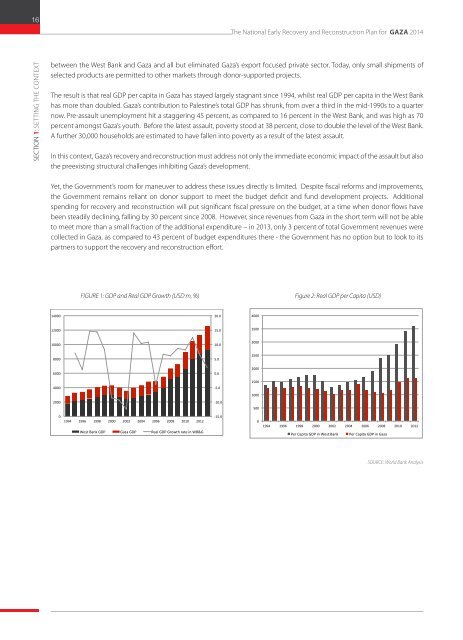National Early Recovery and Reconstruction Plan for Gaza 2014-2017_FINAL
National Early Recovery and Reconstruction Plan for Gaza 2014-2017_FINAL
National Early Recovery and Reconstruction Plan for Gaza 2014-2017_FINAL
You also want an ePaper? Increase the reach of your titles
YUMPU automatically turns print PDFs into web optimized ePapers that Google loves.
16The <strong>National</strong> <strong>Early</strong> <strong>Recovery</strong> <strong>and</strong> <strong>Reconstruction</strong> <strong>Plan</strong> <strong>for</strong> <strong>Gaza</strong> <strong>2014</strong>SECTION 1: Setting the Contextbetween the West Bank <strong>and</strong> <strong>Gaza</strong> <strong>and</strong> all but eliminated <strong>Gaza</strong>’s export focused private sector. Today, only small shipments ofselected products are permitted to other markets through donor-supported projects.The result is that real GDP per capita in <strong>Gaza</strong> has stayed largely stagnant since 1994, whilst real GDP per capita in the West Bankhas more than doubled. <strong>Gaza</strong>’s contribution to Palestine’s total GDP has shrunk, from over a third in the mid-1990s to a quarternow. Pre-assault unemployment hit a staggering 45 percent, as compared to 16 percent in the West Bank, <strong>and</strong> was high as 70percent amongst <strong>Gaza</strong>’s youth. Be<strong>for</strong>e the latest assault, poverty stood at 38 percent, close to double the level of the West Bank.A further 30,000 households are estimated to have fallen into poverty as a result of the latest assault.In this context, <strong>Gaza</strong>’s recovery <strong>and</strong> reconstruction must address not only the immediate economic impact of the assault but alsothe preexisting structural challenges inhibiting <strong>Gaza</strong>’s development.Yet, the Government’s room <strong>for</strong> maneuver to address these issues directly is limited. Despite fiscal re<strong>for</strong>ms <strong>and</strong> improvements,the Government remains reliant on donor support to meet the budget deficit <strong>and</strong> fund development projects. Additionalspending <strong>for</strong> recovery <strong>and</strong> reconstruction will put significant fiscal pressure on the budget, at a time when donor flows havebeen steadily declining, falling by 30 percent since 2008. However, since revenues from <strong>Gaza</strong> in the short term will not be ableto meet more than a small fraction of the additional expenditure – in 2013, only 3 percent of total Government revenues werecollected in <strong>Gaza</strong>, as compared to 43 percent of budget expenditures there - the Government has no option but to look to itspartners to support the recovery <strong>and</strong> reconstruction ef<strong>for</strong>t.FIGURE 1: GDP <strong>and</strong> Real GDP Growth (USD m, %)FIGURE 1: GDP <strong>and</strong> Real GDP Growth (USD m, %) Figure 2: Real GDP per Capita (USD) Figure 2: Real GDP per Capita (USD)14000 20.0 4000 12000 15.0 3500 10000 10.0 3000 8000 6000 4000 2000 0 1994 1996 1998 2000 2002 2004 2006 2008 2010 2012 West Bank GDP <strong>Gaza</strong> GDP Real GDP Growth rate in WB&G 5.0 0.0 -‐5.0 -‐10.0 -‐15.0 2500 2000 1500 1000 500 0 1994 1996 1998 2000 2002 2004 2006 2008 2010 2012 Per Capita GDP in West Bank Per Capita GDP in <strong>Gaza</strong> SOURCE: World Bank Analysis


